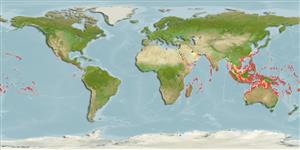Actinopterygii (ray-finned fishes) >
Beryciformes (Sawbellies) >
Holocentridae (Squirrelfishes, soldierfishes) > Myripristinae
Etymology: Myripristis: Greek, myros, -ou = male of morey eel + Greek, pristis = saw (Ref. 45335).
Environment / Climate / Range
Ecology
Marine; reef-associated; depth range 1 - 50 m (Ref. 9710). Tropical, preferred ?; 30°N - 35°S
Indo-Pacific: Red Sea (including the Gulf of Oman) and East Africa to Oceania.
Length at first maturity / Size / Weight / Age
Maturity: Lm 17.5 range ? - ? cm
Max length : 60.0 cm TL male/unsexed; (Ref. 240); common length : 18.0 cm TL male/unsexed; (Ref. 30573)
Dorsal
spines
(total): 11;
Dorsal
soft rays
(total): 13-15;
Anal
spines: 4;
Anal
soft rays: 11 - 14. Body color silvery pink; edge of scales red; opercular margin black; all fins red; submarginal band in each caudal fin lobe; leading edges of median fins white. Inner pectoral axil with numerous small scales. Differs from M. amaena by possessing prominent white leading edges on its soft dorsal, anal, and tail fins, and from M. berndti by having a deep red spinous dorsal fin (Ref. 1602).
Occur in reef flats and shallow lagoon and seaward reefs (Ref. 12419). Benthopelagic in or near crevices and caves (Ref. 58302). Mainly nocturnal. Feed mainly on plankton such as crab larvae (Ref. 12419). Secretive, hovering under ledges and in caves (Ref. 37816). Oviparous, with planktonic eggs and larvae (Ref. 240).
Life cycle and mating behavior
Maturity | Reproduction | Spawning | Eggs | Fecundity | Larvae
Randall, J.E. and D.W. Greenfield, 1996. Revision of the Indo-Pacific holocentrid fishes of the genus Myripristis, with descriptions of three new species. Indo-Pac. Fish. (25):61 p. (Ref. 12419)
IUCN Red List Status (Ref. 115185)
CITES (Ref. 94142)
Not Evaluated
Threat to humans
Reports of ciguatera poisoning (Ref. 4690)
Human uses
Fisheries: minor commercial; aquarium: commercial
More information
ReferencesAquacultureAquaculture profileStrainsGeneticsAllele frequenciesHeritabilityDiseasesProcessingMass conversion
Tools
Special reports
Download XML
Internet sources
Estimates of some properties based on models
Phylogenetic diversity index (Ref.
82805): PD
50 = 0.5000 [Uniqueness, from 0.5 = low to 2.0 = high].
Bayesian length-weight: a=0.01698 (0.01015 - 0.02841), b=3.08 (2.94 - 3.22), in cm Total Length, based on LWR estimates for this species & Genus-body shape (Ref.
93245).
Trophic Level (Ref.
69278): 3.4 ±0.1 se; Based on diet studies.
Resilience (Ref.
69278): Medium, minimum population doubling time 1.4 - 4.4 years (Preliminary K or Fecundity.).
Vulnerability (Ref.
59153): Low to moderate vulnerability (35 of 100) .
